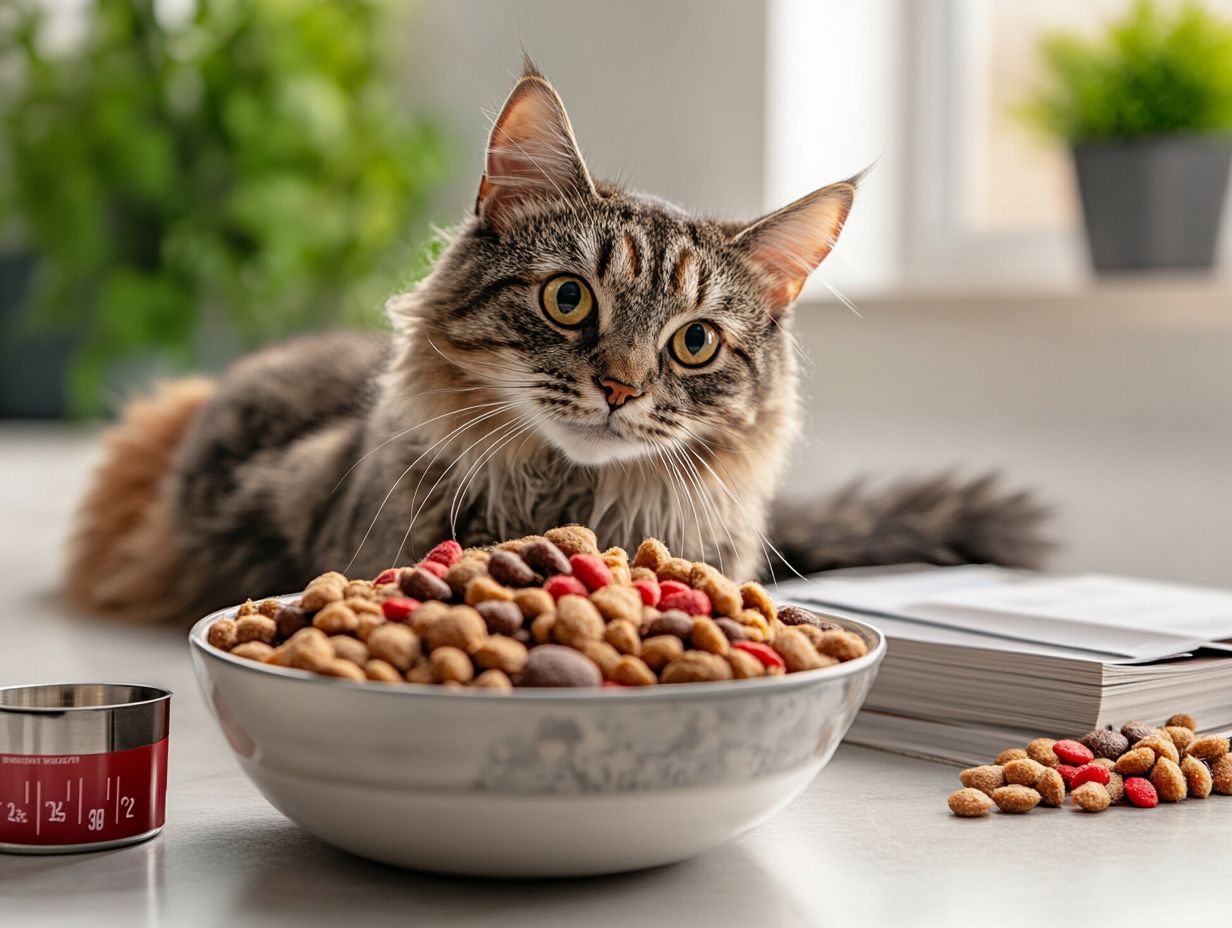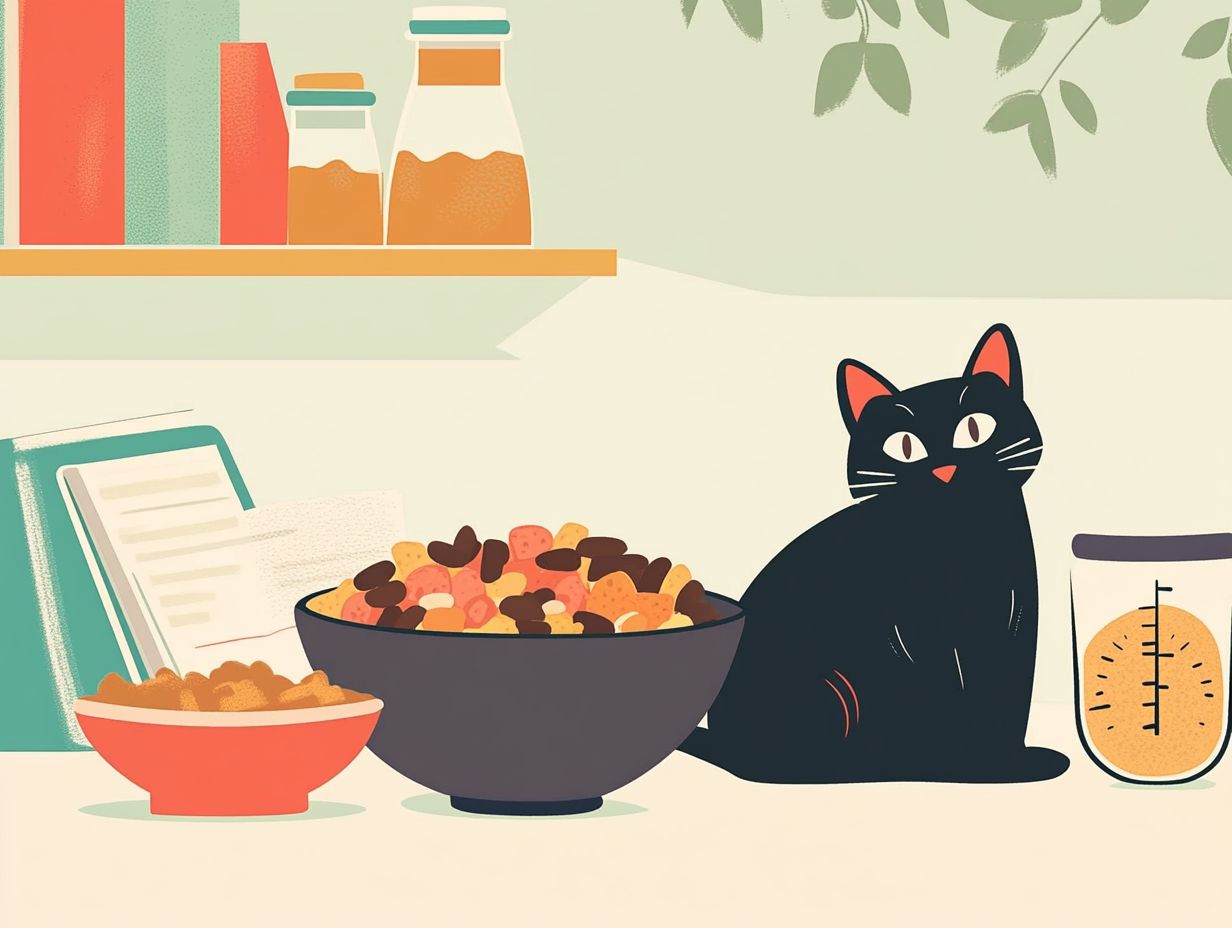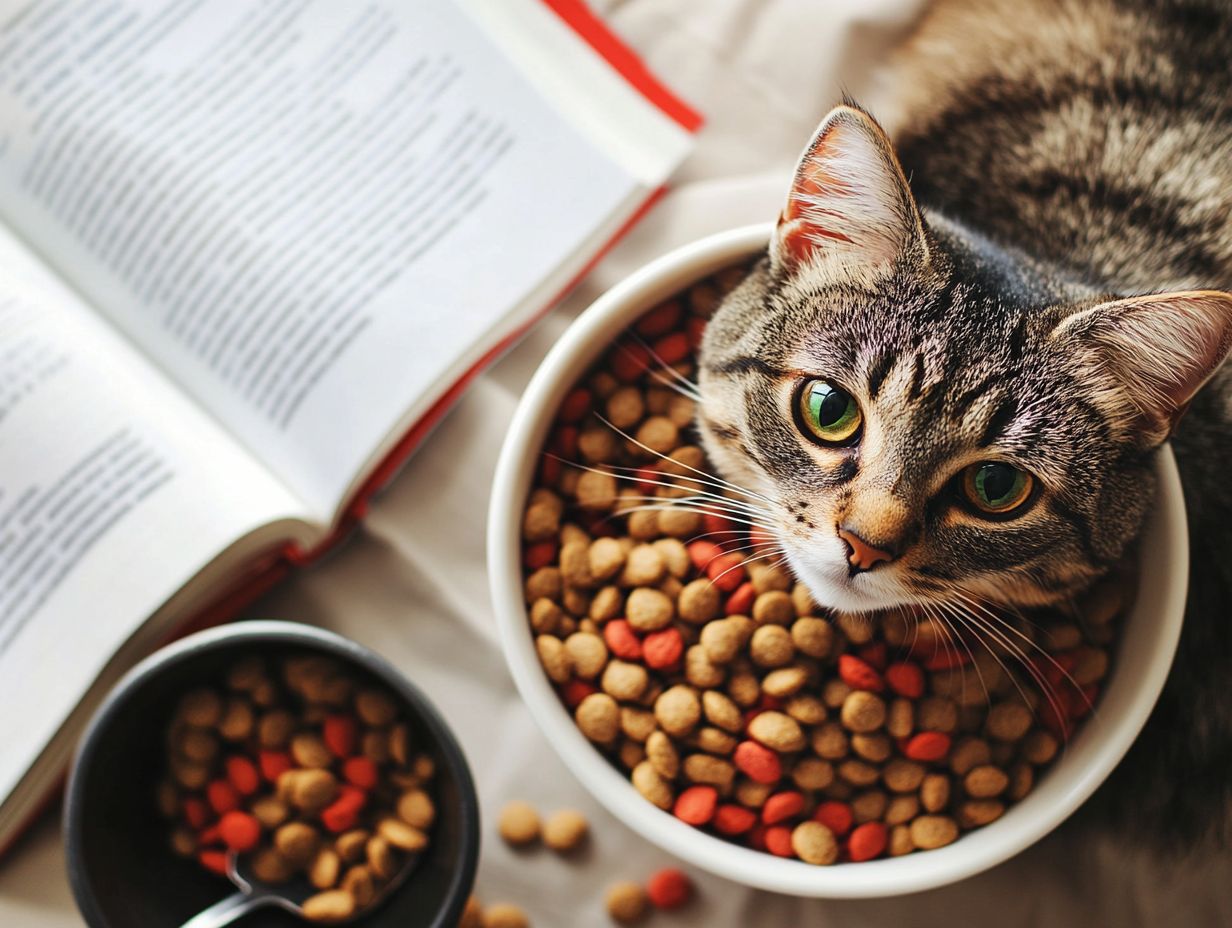Understanding your cat’s nutritional needs is essential for their overall health and well-being. Like humans, cats require a balanced diet that is specifically tailored to their unique biology.
This article explores the fundamentals of feline nutrition, highlighting essential nutrients such as protein, fats, and carbohydrates.
We will examine various commercial cat food options, discussing the pros and cons of homemade diets as well. Additionally, special dietary considerations for different life stages and health conditions will be addressed, along with practical feeding tips to ensure that your feline friend thrives.
The Basics of Feline Nutrition

Understanding the fundamentals of feline nutrition is essential for every cat owner who wishes to maintain their pet’s health and well-being. A healthy diet for cats caters to their unique dietary needs, which differ significantly from those of other pets.
The basics of a cat’s diet specifically emphasize the importance of high-quality ingredients that meet their nutritional requirements and promote overall feline health. Feline dietary needs include an optimal balance of proteins, fats, carbohydrates, vitamins, and minerals that are vital for their overall well-being and play a crucial role in preventing various health issues throughout their lives.
Understanding a Cat’s Unique Dietary Needs
Cats have specific dietary needs due to their evolutionary biology, making it essential for cat owners to understand how to nourish them properly. As obligate carnivores, cats must consume meat to fulfill a significant portion of their daily nutritional requirements. This necessity arises because cats require high-protein diets to support their growth, energy levels, muscle maintenance, and nutrient absorption.
Awareness of potential nutritional deficiencies can help prevent common health issues in felines, so it is crucial for all cat owners to be informed about their pets’ dietary needs.
The digestive system of cats is adapted to process high-protein and low-carbohydrate foods. Their short intestinal tract efficiently absorbs essential nutrients; however, inadequate dietary sources can lead to severe health problems. For example, a deficiency in taurine, which is an essential amino acid, can result in catastrophic nutritional issues such as dilated cardiomyopathy (a form of heart disease) or retinal degeneration (vision problems).
Cat owners should be vigilant for signs of nutritional deficiencies in their pets, which may manifest as lethargy, poor coat condition, or changes in appetite. Regular visits to the veterinarian can help ensure that a cat’s diet meets all necessary nutritional requirements for optimal health.
Key Nutrients for Cats
Cat owners must recognize the key nutrients that should be included in their cat’s diet to support their overall well-being. A balanced cat food should contain suitable protein sources, healthy fats, the right carbohydrates, and essential vitamins and minerals.
For instance, taurine is an essential amino acid crucial for heart function and vision, making it a vital component of any cat’s diet. By understanding the significance of these nutrients, you can create a comprehensive feeding plan that meets your cat’s individual nutritional requirements.
Protein, Fat, Carbohydrates, and Other Essential Nutrients

A cat’s diet is comprised of macronutrients such as protein, fats, and carbohydrates, each of which plays a crucial role in meeting a cat’s dietary needs. High-quality protein from animal sources is essential for muscle development and energy, while healthy fats are necessary for energy and proper cellular function. Although carbohydrates are not as critical, they can be beneficial in small amounts for providing energy and fiber.
Understanding the significance of these macronutrient categories and their nutrient density will help pet owners select appropriate foods for their cats, taking into account their preferences for food texture. The ideal ratios and combinations of these macronutrients can vary significantly based on a cat’s life stage—whether it is a kitten, adult cat, or senior cat.
For example, kittens require a higher protein content to support their rapid growth, while adult cats thrive on a balanced ratio that includes higher healthy fats for sustained energy. Senior cats benefit from a lower carbohydrate content to maintain their overall health, with a focus on nutrient-dense ingredients that are easier to digest.
By prioritizing nutrient density in food choices and adjusting the ratios of these macronutrients, pet owners can significantly enhance their cats’ vitality and longevity.
Commercial Cat Food Options
A key consideration in ensuring proper nutrition for cats is the choice between commercial cat food and homemade diets. Commercial cat food includes a variety of options, such as wet and dry food, each offering different benefits and convenience for pet owners.
Premium cat food brands typically use high-quality ingredients and create products tailored to specific dietary needs, while more affordable cat food options may utilize lower-quality ingredients. Understanding nutritional labels is essential for selecting the right product that meets a cat’s specific health requirements.
Types of Cat Food and What to Look For
Understanding the various types of cat food available can help you choose the right option for your feline friend, especially if you are aware of the advantages and disadvantages of each type. There are two main categories of cat food: wet and dry. Wet food is generally more palatable but tends to be more expensive than dry food. On the other hand, dry food is more convenient to store and serve, although it does not provide hydration.
Plus discussing the characteristics of wet and dry food, this article will also cover nutritional labels, the importance of life stage, and other factors to consider when selecting cat food.
Nutritional Labels: It is essential to carefully review the nutritional label of cat food, as the first few ingredients significantly impact your cat’s health.
Choosing Between Wet and Dry Food:
- Wet Food:
- Pros: Higher moisture content
- Cons: More expensive
- Dry Food:
- Pros: More convenient to store and serve
- Cons: Does not aid in hydration
When selecting cat food, consider your cat’s nutritional needs, ensuring the food is appropriate for their life stage and breed characteristics (e.g., indoor vs. outdoor). Additionally, specific health conditions may require tailored diets, such as those for urinary, weight, skin, or gastrointestinal issues.
Homemade Diets for Cats

Homemade diets for cats can be rewarding, as they allow owners complete control over the ingredients and nutritional profile of their pets’ meals. Many cat owners opt for homemade cat food to address their pets’ specific dietary needs, often arising from food allergies or intolerances to ingredients found in commercial diets.
However, it is crucial that these meals meet the nutritional requirements of cats, as unbalanced diets can lead to nutritional deficiencies and related health issues. Veterinary nutritionists can help develop a well-balanced homemade diet plan tailored to the specific health needs of each individual cat.
Pros and Cons of Preparing Your Own Cat Food
The main advantages and disadvantages of homemade cat food include the ability to tailor meals to meet specific health needs and the challenge of ensuring proper nutritional balance.
Advantages of homemade cat food:
- Tailored Nutrition: Homemade diets can effectively address specific health concerns such as food allergies, intolerances, obesity, or chronic conditions.
- Ingredient Control: Preparing homemade meals allows for complete control over the ingredients, resulting in higher-quality meals without fillers or artificial additives commonly found in commercial cat foods.
- Improved Health Outcomes: Clinical studies suggest that well-formulated homemade diets can lead to healthier coats, increased energy levels, improved stool consistency, and better dental health.
Disadvantages of homemade cat food:
- Time and Effort: Cooking for your cat is a time-consuming and labor-intensive process.
- Need for Research and Knowledge: It requires a commitment to researching and understanding how to create a well-balanced diet that includes all essential nutrients. Achieving and maintaining this balance over the long term can be challenging.
- Nutritional Balance: Ensuring an appropriate balance of protein, fiber, and fats can be complex. Ill-informed pet owners risk creating an imbalanced diet, which may lead to future health issues.
Special Dietary Considerations for Cats
Understanding the special dietary considerations for cats is essential, as their nutritional needs can vary significantly based on their life stage and any medical conditions they may have.
For instance, a kitten’s diet must support its rapid growth and development, while a senior cat’s diet should focus on promoting joint and digestive health. Additionally, certain medical conditions that are common in cats may necessitate therapeutic diets tailored to their specific needs.
Being aware of these special dietary requirements will enable you to recognize when dietary changes are necessary to promote optimal feline health throughout their various life stages.
Dietary Needs for Kittens, Senior Cats, and Cats with Health Issues

Kittens, senior cats, and cats with specific health concerns each have unique dietary needs that must be met for them to thrive. A kitten’s diet should be rich in energy and nutrients to support their growth and development, while a diet for senior cats must focus on promoting a healthy lifestyle and weight management. Cats with health issues require specific dietary considerations, such as prescription diets tailored to their conditions. Understanding the differences in diets for kittens, senior cats, and those with health concerns enhances their nutritional education and overall well-being.
Kittens need a diet high in protein and fat to support their rapid growth. Additionally, it is essential to include specific nutrients such as docosahexaenoic acid (DHA), a fatty acid found in fish oil that is vital for brain development and function.
In contrast, senior cats benefit from diets that are high in fiber but low in calories, which aids healthy digestion and facilitates weight management, making it easier for them to maintain a healthy body condition as their metabolism slows down.
Cats with diabetes require foods that are low in carbohydrates to prevent spikes in blood sugar, while those with kidney disease need diets that are low in protein and phosphorus to reduce the workload on their kidneys. Increased hydration is also crucial for supporting kidney function.
Recognizing these differences in dietary needs ensures that all felines receive the specific nutrients necessary for the best possible quality of life.
Feeding Tips for Cats
Effective feeding tips for cats include establishing a feeding schedule, controlling portion sizes, understanding your cat’s feeding behavior, and ensuring access to fresh water. These strategies help ensure that your cat receives the right nutrition in appropriate amounts.
Feeding cats on a schedule can regulate their eating habits and control portions, which helps prevent feline obesity. By understanding your cat’s feeding preferences—such as whether they prefer wet or dry food and when they like to eat—you can enhance their mealtime experience.
Additionally, providing your cat with fresh water is crucial for their health, as it helps prevent issues such as constipation and urinary tract infections.
Portion Control, Meal Frequency, and Other Important Feeding Practices
Mastering portion control and meal frequency is essential for ensuring your cat’s overall wellness and preventing dietary issues. Implementing appropriate portion sizes tailored to your cat’s age, weight, and activity level can help maintain a healthy body condition and reduce the risk of feline obesity.
Establishing a consistent meal schedule is crucial for managing your cat’s feeding behavior and promoting a positive mealtime routine. By following these feeding practices, you can significantly contribute to your cat’s long-term health and happiness.
Portion sizes not only aid in weight management but also improve your cat’s digestion. For this reason, it is advisable to break one large meal into smaller portions and distribute them throughout the day. When determining your cat’s daily food portions, it is best to consider their natural feeding habits. Cats are opportunistic eaters, having evolved to consume small amounts frequently rather than large quantities infrequently. Offering small, more frequent meals can mimic this natural behavior, making mealtimes more enjoyable and engaging.
Introducing set feeding times can also help establish a routine, which can reduce begging and anxiety around mealtimes. Regularly checking your cat’s body condition score can assist in determining if portion sizes need adjustment, ensuring that their nutritional needs are adequately met.
